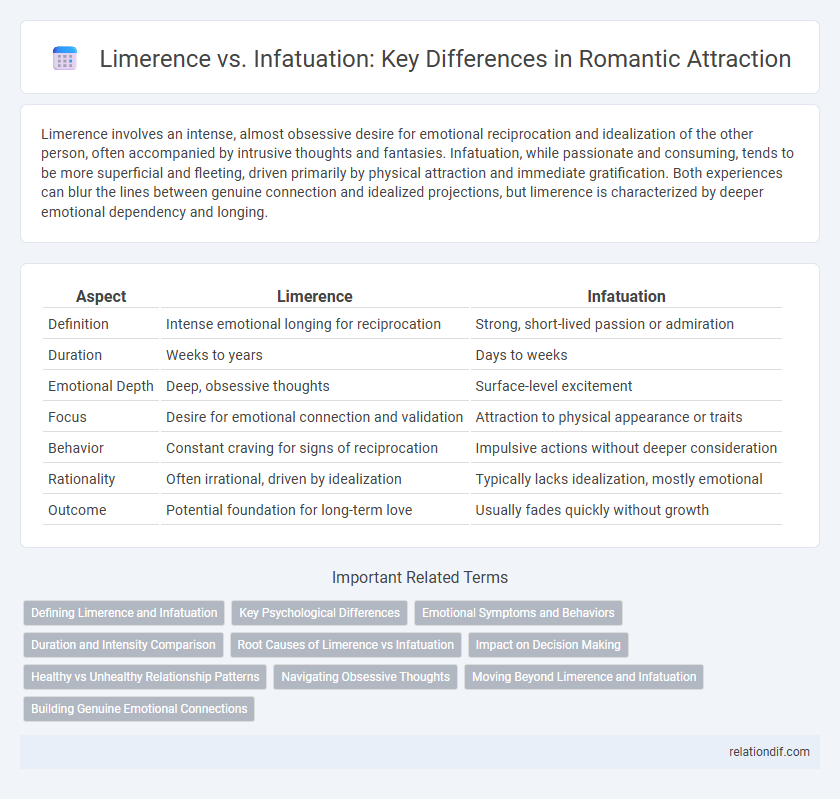Limerence involves an intense, almost obsessive desire for emotional reciprocation and idealization of the other person, often accompanied by intrusive thoughts and fantasies. Infatuation, while passionate and consuming, tends to be more superficial and fleeting, driven primarily by physical attraction and immediate gratification. Both experiences can blur the lines between genuine connection and idealized projections, but limerence is characterized by deeper emotional dependency and longing.
Table of Comparison
| Aspect | Limerence | Infatuation |
|---|---|---|
| Definition | Intense emotional longing for reciprocation | Strong, short-lived passion or admiration |
| Duration | Weeks to years | Days to weeks |
| Emotional Depth | Deep, obsessive thoughts | Surface-level excitement |
| Focus | Desire for emotional connection and validation | Attraction to physical appearance or traits |
| Behavior | Constant craving for signs of reciprocation | Impulsive actions without deeper consideration |
| Rationality | Often irrational, driven by idealization | Typically lacks idealization, mostly emotional |
| Outcome | Potential foundation for long-term love | Usually fades quickly without growth |
Defining Limerence and Infatuation
Limerence is an intense, involuntary emotional state characterized by obsessive thoughts, longing for reciprocation, and acute sensitivity to a partner's actions, often involving idealization and fear of rejection. Infatuation is a short-lived passion or admiration for someone, driven primarily by physical attraction and idealized perceptions without deep emotional connection. Both experiences influence romantic attraction but differ in depth, duration, and cognitive involvement, with limerence involving more profound emotional dependency.
Key Psychological Differences
Limerence involves an intense longing for reciprocation characterized by intrusive thoughts and emotional dependency, while infatuation tends to be a brief, superficial attraction driven by physical or idealized traits. Neuroscientific studies reveal limerence activates brain regions linked with reward and craving, such as the ventral tegmental area, whereas infatuation engages more transient dopamine surges without deep emotional attachment. Psychologically, limerence often leads to obsessive rumination and anxiety over potential rejection, contrasting with the fleeting excitement and passion typical of infatuation.
Emotional Symptoms and Behaviors
Limerence manifests through intense longing, intrusive thoughts, and emotional dependency, often leading to obsessive behaviors such as constant checking for reciprocation and idealizing the person. Infatuation typically involves heightened excitement, superficial attraction, and temporary euphoria, characterized by impulsive actions and exaggerated admiration without deep emotional attachment. Emotional symptoms of limerence include anxiety and mood swings tied to perceived signals, while infatuation centers on thrill-seeking and fascination with physical or surface traits.
Duration and Intensity Comparison
Limerence is characterized by an intense, obsessive longing and typically sustains over weeks to months, often marked by persistent intrusive thoughts and a deep desire for reciprocation. Infatuation tends to be more fleeting, lasting from a few days to a few weeks, with high but less obsessive intensity, primarily driven by physical attraction or immediate emotional excitement. While limerence involves prolonged emotional dependence and anxiety over relationship status, infatuation usually phases out quickly as initial excitement diminishes.
Root Causes of Limerence vs Infatuation
Limerence is rooted in an intense emotional dependency and obsessive longing for reciprocation, often triggered by idealization and heightened dopamine activity in the brain. Infatuation arises from superficial attraction and immediate desire, primarily driven by physical appearance and novelty without deep emotional attachment. Understanding these distinct root causes helps differentiate limerence as a complex psychological state from the more fleeting and surface-level experience of infatuation.
Impact on Decision Making
Limerence heavily influences decision making by creating an intense emotional dependency that can cloud rational judgment and prioritize obsessive thoughts over logical assessment. Infatuation drives impulsive decisions rooted in physical attraction and immediate gratification, often lacking long-term consideration. Both states can lead to compromised choices, but limerence typically results in deeper, more pervasive effects on cognitive processes.
Healthy vs Unhealthy Relationship Patterns
Limerence involves intense longing and emotional dependence, often leading to obsessive thoughts and unrealistic expectations, which can hinder the development of a healthy relationship. Infatuation typically manifests as a short-lived passion driven by physical attraction and idealization, often lacking depth or genuine emotional connection. Recognizing the difference supports cultivating balanced relationships where emotional well-being and mutual respect are prioritized over unhealthy attachment or fleeting desire.
Navigating Obsessive Thoughts
Limerence involves intense obsessive thoughts characterized by an overwhelming desire for reciprocation and constant mental replay of interactions, whereas infatuation is generally more superficial and less consuming. Managing limerence requires cognitive strategies to redirect attention and recognize the patterns of fixation, while infatuation often fades with time without intensive mental engagement. Understanding these distinctions aids in navigating emotional experiences and maintaining mental well-being during attraction.
Moving Beyond Limerence and Infatuation
Moving beyond limerence and infatuation involves developing emotional resilience and fostering authentic connections rooted in mutual understanding. Emphasizing long-term compatibility and open communication enables individuals to transition from obsessive attraction to meaningful relationships. This evolution enhances emotional stability and promotes genuine intimacy beyond initial infatuation phases.
Building Genuine Emotional Connections
Limerence creates intense emotional longing characterized by obsessive thoughts and a desire for reciprocation, often blurring reality with idealization. Infatuation manifests as a temporary, surface-level attraction driven primarily by physical appeal and excitement without deep emotional investment. Building genuine emotional connections requires recognizing the difference, fostering trust, mutual understanding, and consistent communication beyond the fleeting intensity of both limerence and infatuation.
Limerence vs Infatuation Infographic

 relationdif.com
relationdif.com